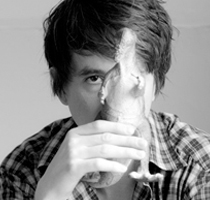I’ve described Thran’s engagement with popular culture and his pronounced lightness in largely positive terms: as a vitalizing, robust grappling with a certain moment in time, a certain localized present. However, what works for some readers may just as well turn others away. Many of the poems quoted or summarized here also perhaps sketch too lightly, skirting weighty emotional and topical concerns and failing to delve to a depth that can allow real insight, revelation, or moving involvement. Poems like “Power,” “Edelweiss,” “The Year of the Gun,” “Glowworms,” “Dopamine,” and “Festival” leave me feeling unmoved and uninvited; I’m not sure what effect – other than airiness – such poems are designed to produce. “Raining in Darling,” while interesting in arrangement, is quite lacklustre if the inspiring and gem-like pop song is brought into comparison. The jokiness of “Thought Bubbles Hovering Over the Canadian Taxidermists Association’s Annual General Meeting” and “Year of the Pineapple” wash over me without much effect (perhaps owing more to a difference in sense of humour than anything else). Thran’s “Seven Cicadas” gives seven haiku-like perspectives on the noise and reputation of the eponymous insect. Given such an arrangement, I don’t think I’m remiss if I’m naturally inclined to compare said poem to Wallace Stevens’ classic, “Thirteen Ways of Looking at a Blackbird.” Though the poem pleases, I’m not sure what Thran’s rendition can offer beyond the innovations set by Stevens. Furthermore, in the poem “A Species a Second” in the collection Back Off Assassin! (Mansfield Press 2009), Toronto poet Jim Smith runs through a catalogue of unfortunate cartoon characters, describing various ways each one is killed or maimed, and ending with the powerfully moving lines, “It is so lonely. It is/ So lonely.” Here, the sunny world of pop culture reaches an elegiac and unforeseen plateau. Thran’s “Cartoon Pyramid,” on the other hand, lists the select activities and relationships of a different set of cartoon characters, but our appreciation or understanding of them and their activities does not deepen or broaden by the conclusion, making Smith’s poem seem all the more sublime and “Cartoon Pyramid” all the more unnecessary.
Stumbles aside, there’s still something terribly attractive about Earworm. Thran is at his sharpest when he juxtaposes his abundant wit and enthusiastic embrace of pop culture with more weighty works of poetry and visual art. He riffs an ekphrastic poem in “David,” juxtaposing Caravaggio’s baroque depiction of the decapitation of the monstrous-yet-mournful-looking Goliath with the “site where they stream the beheadings.” Such juxtaposition throws contemporary voyeurism into haunting comparison with a classical rendering of pain. In “Murder In Hawaiian Shirt,” Thran gives a lurching, sea-faring interpretation of a devouring, violent work by Dennis Oppenheim. Similarly, in Thran’s opening poem, “House by the Railroad,” Edward Hopper’s 1925 painting is taken as ekphrastic inspiration. I love this poem for its curiosity and depth, the sense of a speaker “walking toward” the canvas’ Victorian mansion and his plans to “live there for a time.” Two separate perspectives interpret the manor in Hopper’s painting as a different inanimate object: the first as a piano and the second as a rolltop desk. The poem’s speaker envies his friend’s “second guess,” his refusal to settle for the first image that came to mind, and “the care he took to get [the interpretation] right.” Such a conversation questions our very use of art and entertainment, asserting that a right reading of entertainment (if such a thing is possible) only comes from care and patience, a “second guess” after our first and most knee-jerk responses subside (a consideration that would benefit anyone too quick to dismiss the potential power of pop and other variations of so-called ‘low-brow’ media).
Other works boast a deeper relationship to poetry and its traditional formal constraints – “found” poems, a villanelle, and a pantoum – which elevate Thran’s free verse musings into a lean and cutting music. And in “Chloë,” Thran delightfully translates and transforms the famous Horatian Ode (1.23), shifting the poem’s perspective from the eager male pursuer to the female pursued, Chloë, described by Horace as a skittish fawn seeking her mother’s protection in a wild forest. In Thran’s version, Chloë is a young woman working at a pub, serving “barflies” and “slimeballs openly eyeing [her] appurtenances.” The poem is sucked out of antiquity and given the modernizing accessories of “Chucks” and “Black Flag, punk rock, 80 proof stuff.” However, echoes from Horace’s original still blow through the tight fourteen lines: Chloë strides home through “woods where the paths stay damp,” leaving her beer-pouring job that ensures she’s away from her “mother’s doting.” The most compelling aspect of “Chloë,” though, is Thran’s re-imagining of the male Horatian poet from Chloë‘s perspective: he’s “no predatory cur,” she can admit, and still something of a poet, sending her his “scribbled notes” that no doubt announce his ardent, refined desire. But this Chloë has watched the poet’s literary “fawns slip/ their hooves through … perfectly placed little Os” for “two thousand years;” she’s no clueless recipient of love letters, but an entirely modern girl wise to the literary and objectifying game afoot.
The poem vibrates across multiple historical and cultural levels while still remaining a carefully-wrought, visually appealing construction. Aside from its fearless breaking-away from the old Can Lit standards and its willingness to offer an engaging, common sort of talk, poems like “Chloë” prove that what makes this collection so special is the way high and low forms of entertainment find a warm reception in the same generous voice. In “Chloë,” as in other poems, Thran demonstrates how high and low can be perfect bedfellows with a wise technician working behind the scenes. I have my fingers crossed that the author follows this fruitful path in future collections, mining the collisions that occur across the strata of culture. If the best of what Earworm has to offer is any preview of upcoming work, then I believe that the urban multiplicity swarming through my window – from high to low, from sweet to sorrowful – is in trustworthy hands.





Excellent article. keep it up!